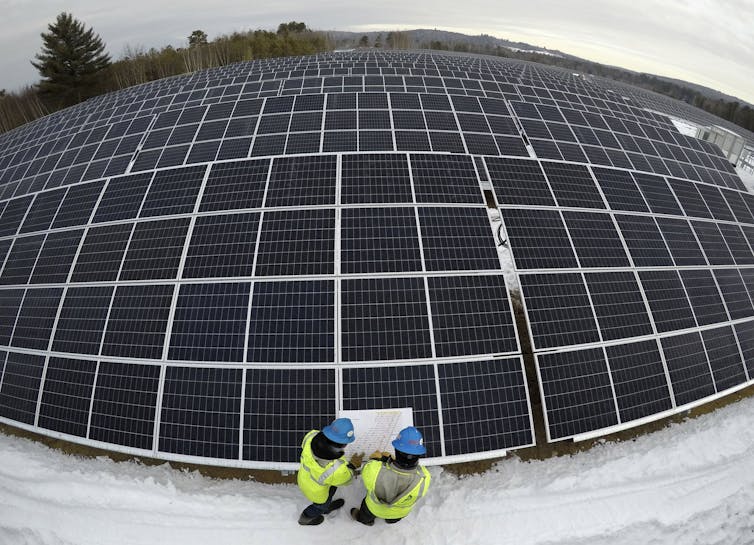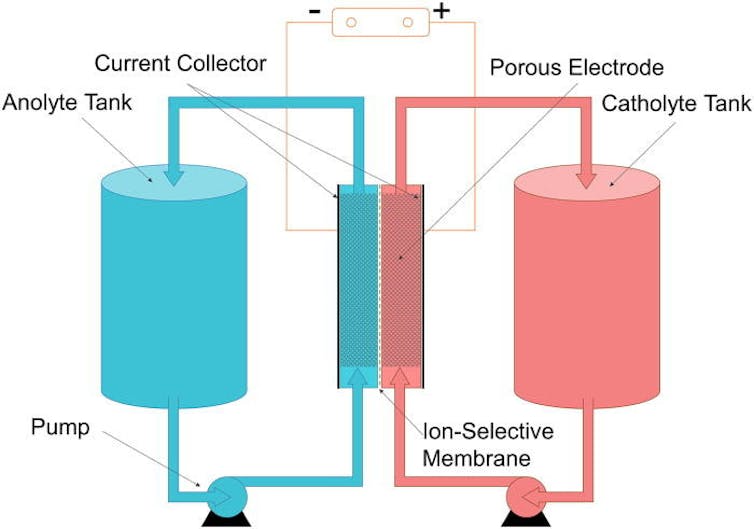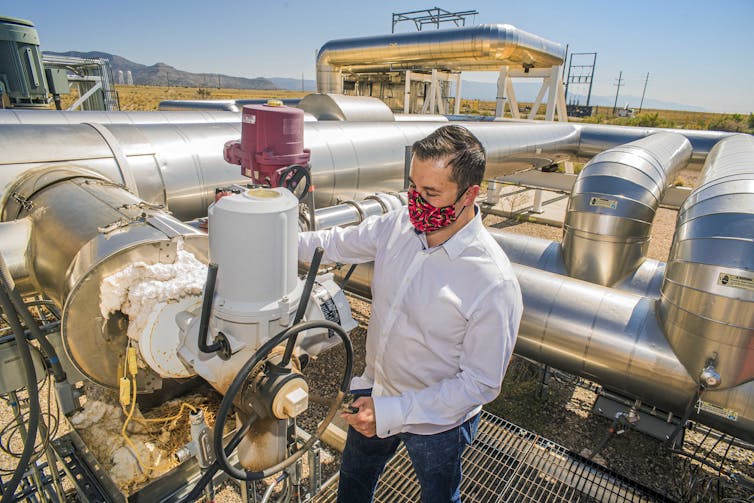
Experts in autocracies have pointed out that it is, unfortunately, easy to slip into normalizing the tyrant, hence it is important to hang on to outrage. These incidents which seem to call for the efforts of the Greek Furies (Erinyes) to come and deal with them will, I hope, help with that. As a reminder, though no one really knows how many there were supposed to be, the three names we have are Alecto, Megaera, and Tisiphone. These roughly translate as “unceasing,” “grudging,” and “vengeful destruction.”
Renewable energy is, by definition, renewable. If you harvest energy from the sun or from the wind, and the sun sets or the wind stops blowing, there will always be more. But in order to make it through the night, or through the calm days, you need to be able to store the energy you harvested while the sun was up and the wind blowing. And, while we do have a lot of ways to store it, we are not as far along as I had hoped in making those ways last long enough and be dependable enough to leave fossil fuels behind just yet. So maybe we need to take stock of the situation.
================================================================
These 3 energy storage technologies can help solve the challenge of moving to 100% renewable electricity

AP Photo/Robert F. Bukaty
Kerry Rippy, National Renewable Energy Laboratory
In recent decades the cost of wind and solar power generation has dropped dramatically. This is one reason that the U.S. Department of Energy projects that renewable energy will be the fastest-growing U.S. energy source through 2050.
However, it’s still relatively expensive to store energy. And since renewable energy generation isn’t available all the time – it happens when the wind blows or the sun shines – storage is essential.
As a researcher at the National Renewable Energy Laboratory, I work with the federal government and private industry to develop renewable energy storage technologies. In a recent report, researchers at NREL estimated that the potential exists to increase U.S. renewable energy storage capacity by as much as 3,000% percent by 2050.
Here are three emerging technologies that could help make this happen.
Longer charges
From alkaline batteries for small electronics to lithium-ion batteries for cars and laptops, most people already use batteries in many aspects of their daily lives. But there is still lots of room for growth.
For example, high-capacity batteries with long discharge times – up to 10 hours – could be valuable for storing solar power at night or increasing the range of electric vehicles. Right now there are very few such batteries in use. However, according to recent projections, upwards of 100 gigawatts’ worth of these batteries will likely be installed by 2050. For comparison, that’s 50 times the generating capacity of Hoover Dam. This could have a major impact on the viability of renewable energy.
Batteries work by creating a chemical reaction that produces a flow of electrical current.
One of the biggest obstacles is limited supplies of lithium and cobalt, which currently are essential for making lightweight, powerful batteries. According to some estimates, around 10% of the world’s lithium and nearly all of the world’s cobalt reserves will be depleted by 2050.
Furthermore, nearly 70% of the world’s cobalt is mined in the Congo, under conditions that have long been documented as inhumane.
Scientists are working to develop techniques for recycling lithium and cobalt batteries, and to design batteries based on other materials. Tesla plans to produce cobalt-free batteries within the next few years. Others aim to replace lithium with sodium, which has properties very similar to lithium’s but is much more abundant.
Safer batteries
Another priority is to make batteries safer. One area for improvement is electrolytes – the medium, often liquid, that allows an electric charge to flow from the battery’s anode, or negative terminal, to the cathode, or positive terminal.
When a battery is in use, charged particles in the electrolyte move around to balance out the charge of the electricity flowing out of the battery. Electrolytes often contain flammable materials. If they leak, the battery can overheat and catch fire or melt.
Scientists are developing solid electrolytes, which would make batteries more robust. It is much harder for particles to move around through solids than through liquids, but encouraging lab-scale results suggest that these batteries could be ready for use in electric vehicles in the coming years, with target dates for commercialization as early as 2026.
While solid-state batteries would be well suited for consumer electronics and electric vehicles, for large-scale energy storage, scientists are pursuing all-liquid designs called flow batteries.

A typical flow battery consists of two tanks of liquids that are pumped past a membrane held between two electrodes.
Qi and Koenig, 2017, CC BY
In these devices both the electrolyte and the electrodes are liquids. This allows for super-fast charging and makes it easy to make really big batteries. Currently these systems are very expensive, but research continues to bring down the price.
Storing sunlight as heat
Other renewable energy storage solutions cost less than batteries in some cases. For example, concentrated solar power plants use mirrors to concentrate sunlight, which heats up hundreds or thousands of tons of salt until it melts. This molten salt then is used to drive an electric generator, much as coal or nuclear power is used to heat steam and drive a generator in traditional plants.
These heated materials can also be stored to produce electricity when it is cloudy, or even at night. This approach allows concentrated solar power to work around the clock.

Randy Montoya, Sandia Labs/Flickr, CC BY-NC-ND
This idea could be adapted for use with nonsolar power generation technologies. For example, electricity made with wind power could be used to heat salt for use later when it isn’t windy.
Concentrating solar power is still relatively expensive. To compete with other forms of energy generation and storage, it needs to become more efficient. One way to achieve this is to increase the temperature the salt is heated to, enabling more efficient electricity production. Unfortunately, the salts currently in use aren’t stable at high temperatures. Researchers are working to develop new salts or other materials that can withstand temperatures as high as 1,300 degrees Fahrenheit (705 C).
One leading idea for how to reach higher temperature involves heating up sand instead of salt, which can withstand the higher temperature. The sand would then be moved with conveyor belts from the heating point to storage. The Department of Energy recently announced funding for a pilot concentrated solar power plant based on this concept.
Advanced renewable fuels
Batteries are useful for short-term energy storage, and concentrated solar power plants could help stabilize the electric grid. However, utilities also need to store a lot of energy for indefinite amounts of time. This is a role for renewable fuels like hydrogen and ammonia. Utilities would store energy in these fuels by producing them with surplus power, when wind turbines and solar panels are generating more electricity than the utilities’ customers need.
Hydrogen and ammonia contain more energy per pound than batteries, so they work where batteries don’t. For example, they could be used for shipping heavy loads and running heavy equipment, and for rocket fuel.
Today these fuels are mostly made from natural gas or other nonrenewable fossil fuels via extremely inefficient reactions. While we think of it as a green fuel, most hydrogen gas today is made from natural gas.
Scientists are looking for ways to produce hydrogen and other fuels using renewable electricity. For example, it is possible to make hydrogen fuel by splitting water molecules using electricity. The key challenge is optimizing the process to make it efficient and economical. The potential payoff is enormous: inexhaustible, completely renewable energy.
[Understand new developments in science, health and technology, each week. Subscribe to The Conversation’s science newsletter.]![]()
Kerry Rippy, Researcher, National Renewable Energy Laboratory
This article is republished from The Conversation under a Creative Commons license. Read the original article.
================================================================
Alecto, Megaera, and Tisiphone, we all know that only an idiot would say “if you just have solar power you have no light at night,” or “you only have wind energy when the wind is blowing.” And that is because these technologies utilize storage. And I guess I thought we were farther along in storage than we in fact are. We need better storage, and we need it cheaper – both in terms of the money it costs consumers, and also in terms of how resources are used. Any help from you ladies wold be deeply appreciated.
The Furies and I will be back.
8 Responses to “Everyday Erinyes #281”
Sorry, the comment form is closed at this time.

Love the progress reported here–thanks Joanne! And I have priced lithium solar battery storage and capacity–three years it wasn’t possible to find capacity for home heat/air system energy need and the cost is what 3 yrs. ago supported minimal needs of refrigerator, computer and light approx.
Very interesting – but I’m sure I didn’t understand every jot and tittle.
What I want to know is: Why do Tesla cars keep running into parked emergency vehicles?
It’s like a Siren’s song (no pun intended).
https://slate.com/technology/2021/08/teslas-allegedly-hitting-emergency-vehicles-why-it-could-be-happening.html
https://www.cnn.com/2021/08/16/business/tesla-autopilot-federal-safety-probe/index.html
https://www.reuters.com/business/autos-transportation/us-opens-formal-safety-probe-into-tesla-autopilot-crashes-2021-08-16/
Thanks for an excellent overview of renewable energy storage.
We put solar panels on our little house here in Queensland 8 years ago because the QLD government subsidised it. Even then we said that the next step needed to be subsidizing batteries and even more importantly subsidizing research into new forms of electricity storage. Instead, the Australian government cut the budgets of renewable energy storage and actually started subsidizing coal more than ever, because “the jobs couldn’t be lost”. Now we are the most backward “developed” country with regard to renewable energy on the planet. And there’s no way to make up for a decade of lost time should our local “Republicans” reconsider putting resources towards the right goals.
BTW, I watched a program on renewables and storage 3-4 years ago which showed some engineers who had adapted solar panels so that they didn’t produce electricity but hydrogen instead. That could lead the way to cars driving on hydrogen, which is an easy switch. There’s no reason to have either electric or hydrogen-powered cars, both could be viable and even a hybrid of the two, like the hybrids between electric and petrol, would work.
First of all, glad to see you’re feeling better
Also, always glad to read your comments on anything scientific. If it’s something you don’t already know, you do your research (and do it well) and you jave a knoack for explaining things simplt. Hydrogen fuel is a new thing to me and most interesting.
Great article about renewable solar energy/storage.
I went with having solar panels placed on my home over 5 years ago. That was because my local Gas and Electric company started their Tier System, which started off as a Two Tier, to what they currently have now which is a Four Tiers. We also are asked to now use major appliances during 4 PM and 9 PM daily, which they call “Peak hours”.
At the time I got the solar, they didn’t offer energy storage batteries then. Now that I’ve thought about looking into getting one, they keep telling me that supposedly they’re currently testing to create a way they can retrofit older solar panels to be able to work with a storage battery. Otherwise, they told me if I wanted a storage battery now, I would have to get another 8 panels added to my home. So I’ve put the thought off, since I don’t really need a solar battery storage at this moment, I’ll just wait.
With the gas prices continuing to be so high here in San Diego, thanks to the multiple taxes they apply to our gas prices in California, I’ve thought about looking into an buying an electric car. Besides the cost of them, I had been worried about the safety of them. It seems like every week I’ve been hearing on the news about numerous fires/explosions due to their batteries. So it has turned me away from even thinking of them at this time. Maybe in the next year or so, they’ll improve their batteries and make them safer to own and drive. Plus the cost of them will come down, with more car makers going into manufacturing them.
Thanks Joanne
Fascinating. The only part of what you are seeing there that I am seeing where I am is that the gas prices are high (and every state does have gas taxes. The theory is they they are supposed to go to maintaining highways, but it doesn’t work that way And the higher they are, the harder for politicians to give them up.)
I agree, Joanne. What has me worried right now is that Cal Trans is trying to get a new bill created that will charge Californians 2 cents or more for every mile that we drive. They’re trying to get less people driving cars and off our roads and more on their buses, trolleys and trains. The only issue I have is that where I go for Physical therapy 2 times a week and the arm doctors I go to, there isn’t any buses that go to their locations. I’m hoping to find out when they’re going to start allowing people to speak their feeling about the issue online or many a Zoom meeting.
Yes, public transportation is great, if one isn’t disabled (unless one lives in a place that has special transportation for the disabled – and that is often not satisfactory. Look at all the issues TC had with disabled transportation.) Keep us posted on developments.